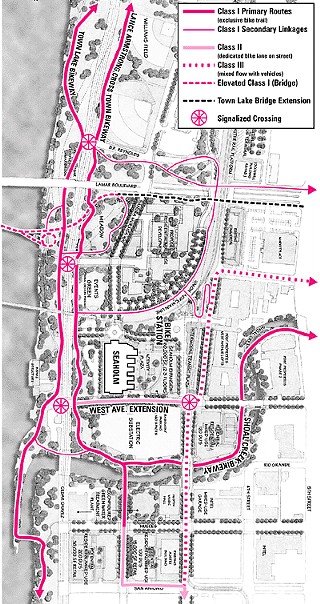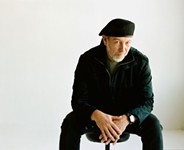Naked City
Pedal Power
By Dan Oko, Fri., June 15, 2001

Bicyclists know better than most that the squeaky wheel gets the grease, which helps explain why a few outspoken cycling advocates are making so much noise over the rehabilitation of the Seaholm Power Plant near Cesar Chavez and Lamar. The out-of-commission plant, built in the 1950s on a rise overlooking Town Lake, sits at what alternative transportation gurus call a "dynamic nexus" for all kinds of transportation. It's near major urban arterials such as Lamar, and close enough to Shoal Creek -- and the favored route of the proposed Lance Armstrong Bikeway (formerly the Crosstown Bikeway) -- to provide hikers and bikers from all over with a path for a safe and pleasant commute. But while urban planners promise that "bike/ped" concerns will be addressed as the Seaholm District Master Plan works its way toward City Council chambers this summer, cyclists say not enough is being done to address their concerns.
"I wouldn't mind if the Seaholm Master Plan just died a quiet death," says the plan's most outspoken critic, Tommy Eden, who serves on the city's Urban Transportation Commission. Eden worries that proposed bike routes are going to lose out to planning for automotive traffic and parking lots, which could throw up physical and financial obstacles for bikeways around Seaholm. "What they're proposing is woefully inadequate," he says flatly. "They need to redesign the master plan to accommodate cyclists."
Eric Anderson, an Austin cycling activist who's worked to promote the crosstown bikeway, says that while things aren't exactly being done "backwards," "I don't see much of what I or other bicyclists contributed included in the final redesign plan." As one example, Anderson points to the fact that high bids prompted the city to leave out of the master plan a proposal to connect the new bike/ped bridge over Town Lake -- which opens this Saturday with a 9:30am ceremony -- to its original destination at Fifth and Lamar, a route that would have carried bicyclists through the heart of the Seaholm district. Right now, it looks unlikely that the city will allocate the $2.5 million it would cost to build the bridge extension any time soon.
Moreover, cycling advocates complain that the details of just how the district trail interchange will work remain excessively vague -- to the point, according to some, of being unacceptable. Anderson and Eden say they won't be satisfied until the master plan officially integrates potential bike/ped routes; although they acknowledge that challenges remain, because many routes have yet to be worked out by city staff, including public works and transportation planners. Still, at this point, says Anderson, the plan "does not seem to meet the potential of bringing all these non-motorized trailways together."
A look at the 60-page Master Plan produced last April indicates that alternative transportation has been on planners' minds. Although the architectural overview of the plan only shows dotted outlines where potential bike paths might go, a section of the plan devoted to "Bicycle and Pedestrian Circulation" outlines a strategy for accommodating non-motorized traffic, particularly along Shoal Creek and the crosstown bikeway. There's even a proposed bike station with lockers and showers on the northwest corner of the Seaholm property. "We worked very hard on this plan to make it compatible with a lot of different modes of transportation," says Jana McCann, the city's urban design officer, "and we recognize bikes in this area are very important."
"There is some legitimate concern over the resolution of the new bicycle-pedestrian bridge project," McCann continues, but she attributes most complaints about the master plan to "fear of the unknown … There's always a few people that complain. They have a tendency to cry wolf, and worry that something is going to be taken away."
Not all cyclists are sweating the plan. Chris Riley of the Downtown Austin Neighborhood Association, who has lived "car-free" for several months, says he likes what he's seen so far. "It's a very exciting thing to plan, because it is the nexus of so many bike/ped trails," Riley says, "You can envision this great hub, with bicycles and pedestrians coming right through this area … It's still going to be a long process, but I think we will ultimately be able to resolve all these issues."
Got something to say on the subject? Send a letter to the editor.








